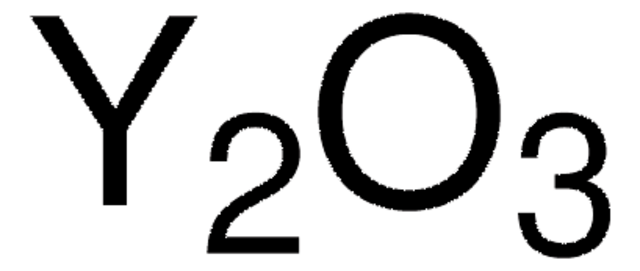450812
Copper(II) oxide
powder, 99.99% trace metals basis
Synonym(s):
Cupric oxide
About This Item
Recommended Products
Assay
99.99% trace metals basis
form
powder
application(s)
battery manufacturing
SMILES string
[Cu]=O
InChI
1S/Cu.O
InChI key
QPLDLSVMHZLSFG-UHFFFAOYSA-N
Looking for similar products? Visit Product Comparison Guide
General description
Application
- Copper(II) Oxide Nanoparticles Embedded within a PEDOT Matrix for Hydrogen Peroxide Electrochemical Sensing.: This study explores the use of copper(II) oxide nanoparticles embedded in a PEDOT matrix for effective hydrogen peroxide electrochemical sensing, highlighting the material′s potential in energy storage applications (Lete et al., 2022).
- Green Fabrication of Nonenzymatic Glucose Sensor Using Multi-Walled Carbon Nanotubes Decorated with Copper (II) Oxide Nanoparticles for Tear Fluid Analysis.: Researchers developed a nonenzymatic glucose sensor using copper(II) oxide nanoparticles on multi-walled carbon nanotubes, showcasing copper oxide′s versatility in high-capacity energy storage solutions and renewable energy applications (Asgari Kheirabadi et al., 2022).
- Facile Synthesis of Copper(II) Oxide Nanospheres Covered on Functionalized Multiwalled Carbon Nanotubes Modified Electrode as Rapid Electrochemical Sensing Platform for Super-Sensitive Detection of Antibiotic.: This paper discusses the synthesis of copper(II) oxide nanospheres on multiwalled carbon nanotubes, emphasizing their application in rapid and sensitive electrochemical sensing, relevant to battery technology (Chen et al., 2019).
- Composite Planar Electrode for Sensing Electrochemical Oxygen Demand.: This study focuses on the development of a composite planar electrode incorporating copper(II) oxide for sensing electrochemical oxygen demand, relevant to improving battery efficiency (Orozco et al., 2008).
Signal Word
Warning
Hazard Statements
Precautionary Statements
Hazard Classifications
Aquatic Acute 1 - Aquatic Chronic 1
Storage Class Code
13 - Non Combustible Solids
WGK
WGK 3
Flash Point(F)
Not applicable
Flash Point(C)
Not applicable
Personal Protective Equipment
Certificates of Analysis (COA)
Search for Certificates of Analysis (COA) by entering the products Lot/Batch Number. Lot and Batch Numbers can be found on a product’s label following the words ‘Lot’ or ‘Batch’.
Already Own This Product?
Find documentation for the products that you have recently purchased in the Document Library.
Customers Also Viewed
Articles
Mechanical alloying is a “brute force” method of affecting alloying and chemical reactions. The mixture of reactant powders and several balls are placed in the milling jar of a high-energy ball mill, for example, a shaker mill or a planetary mill.
Our team of scientists has experience in all areas of research including Life Science, Material Science, Chemical Synthesis, Chromatography, Analytical and many others.
Contact Technical Service





